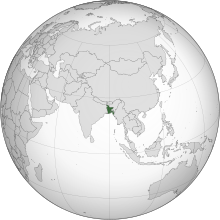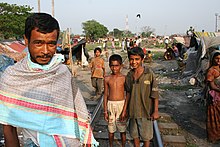
Squatting is the action of occupying an abandoned or unoccupied area of land or a building, usually residential, that the squatter does not own, rent or otherwise have lawful permission to use. The United Nations estimated in 2003 that there were one billion slum residents and squatters globally. Squatting occurs worldwide and tends to occur when people who are poor and homeless find empty buildings or land to occupy for housing. It has a long history, broken down by country below.

A slum is a highly populated urban residential area consisting of densely packed housing units of weak build quality and often associated with poverty. The infrastructure in slums is often deteriorated or incomplete, and they are primarily inhabited by impoverished people. Although slums are usually located in urban areas, in some countries they can be located in suburban areas where housing quality is low and living conditions are poor. While slums differ in size and other characteristics, most lack reliable sanitation services, supply of clean water, reliable electricity, law enforcement, and other basic services. Slum residences vary from shanty houses to professionally built dwellings which, because of poor-quality construction or lack of basic maintenance, have deteriorated.

A shanty town, squatter area or squatter settlement is a settlement of improvised buildings known as shanties or shacks, typically made of materials such as mud and wood. A typical shanty town is squatted and in the beginning lacks adequate infrastructure, including proper sanitation, safe water supply, electricity and street drainage. Over time, shanty towns can develop their infrastructure and even change into middle class neighbourhoods. They can be small informal settlements or they can house millions of people.

Squatting in Zimbabwe is the settlement of land or buildings without the permission of the owner. Squatting began under colonialism. After Zimbabwe was created in 1980, peasant farmers and squatters disputed the distribution of land. Informal settlements have developed on the periphery of cities such as Chitungwiza and the capital Harare. In 2005, Operation Murambatsvina evicted an estimated 700,000 people.

Squatting in Peru is the occupation of unused or derelict buildings or land without the permission of the owner. From the 1940s onwards, land invasions created shanty towns which were first called barriadas and later pueblos jóvenes. They were initially repressed, then the government decided upon toleration and by 1998 it was estimated 2.5 million inhabitants were living in this way in the capital Lima. There are also slum tenements in the centre known as solares or tugurios, and a "Wall of Shame" has been built to separate rich and poor areas of the city. During the COVID-19 pandemic, an increase in the occupation of UNESCO World Heritage Sites such as Caral and the Nazca Lines was reported.

Squatting in Albania began on a large scale in the 1990s after the fall of communism, with internal migration towards formerly collectivised farmland establishing informal settlements. One such area, Bathore on the periphery of the capital Tirana, had 40,000 squatters by the early 2000s who successfully campaigned for better amenities. Other squatters occupied severely polluted post-industrial sites. The Agency of Legalization, Upgrading, and Integration of Informal Zones and Buildings (ALUIZNI) had legalized 16,500 homes on 152 settlements by 2009. As of 2020, 25 per cent of the population of Albania's cities lived in informal settlements.
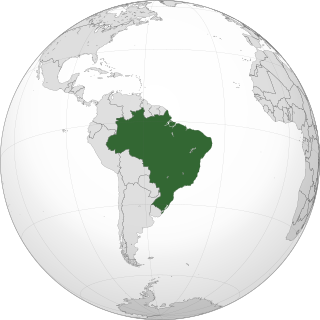
Squatting in Brazil is the occupation of unused or derelict buildings or land without the permission of the owner. After attempting to eradicate slums in the 1960s and 1970s, local governments transitioned to a policy of toleration. Cities such as Recife, Rio de Janeiro and São Paulo have large informal settlements known as favelas. A more recent phenomenon is the occupation of buildings in city centres by organised groups. In rural areas across the country, the Landless Workers' Movement (MST) arranges large land occupations.

Squatting in Pakistan is the occupation of unused land or derelict buildings without the permission of the owner. Squatted informal settlements formed following the creation of Pakistan in 1947. They were known first as "bastis" then later "katchi abadis" and the inhabitants were forcibly resettled under military rule. By 2007, there were 7.5 million squatters in Karachi alone. The Sindh Katchi Abadi Authority (SKAA) announced in 2019 that a total of 1,414 katchi abadis had been located and 1,006 of those had been contacted with regards to beginning a regularization process.
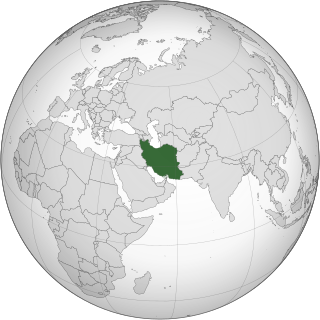
Squatting in Iran mostly occurs around the major cities, as rural migrants move to urban centres. From the 1950s onwards shanty towns have been set up and inhabitants are known as "koukhnishinan". Following the Iranian Revolution of 1979, squatter settlements increased, with the state sometimes evicting and sometimes legalizing the areas.

Squatting in Sudan is defined as the "acquisition and construction of land, within the city boundaries for the purpose of housing in contradiction to Urban Planning and Land laws and building regulations." These informal settlements arose in Khartoum from the 1920s onwards, swelling in the 1960s. By the 1980s, the government was clearing settlements in Khartoum and regularizing them elsewhere. It was estimated that in 2015 that were 200,000 squatters in Khartoum, 180,000 in Nyala, 60,000 in Kassala, 70,000 in Port Sudan and 170,000 in Wad Madani.

Squatting in the Philippines occurs when people build makeshift houses called "barong-barong"; urban areas such as Metro Manila, Metro Cebu, and Metro Davao have large informal settlements. The Philippine Statistics Authority has defined a squatter, or alternatively "informal dwellers", as "One who settles on the land of another without title or right or without the owner's consent whether in urban or rural areas". Squatting is criminalized by the Urban Development and Housing Act of 1992, also known as the Lina Law. There have been various attempts to regularize squatter settlements, such as the Zonal Improvement Program and the Community Mortgage Program. In 2018, the Philippine Statistics Authority estimated that out of the country's population of about 106 million, 4.5 million were homeless.

Squatting in Angola occurs when displaced peoples occupy informal settlements in coastal cities such as the capital Luanda. The Government of Angola has been criticized by human rights groups for forcibly evicting squatters and not resettling them.
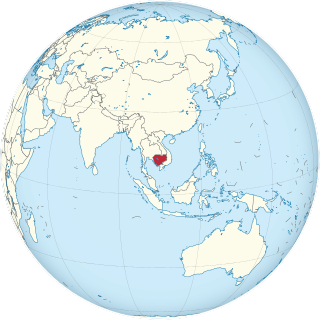
Squatting in Cambodia is the occupation of derelict buildings or unused land without the permission of the owner. Following the Khmer Rouge and the Pol Pot regime, the new democratic government introduced land reform. In the capital Phnom Penh, where in 2003 an estimated 25 per cent of the population was squatting, there are informal settlements and occupied buildings.
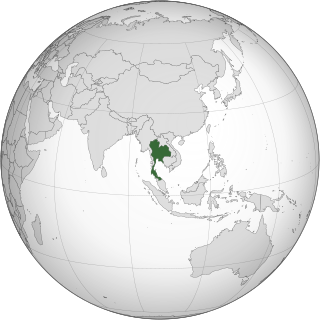
Squatting in Thailand was traditionally permissible under customary law and adverse possession can occur after ten years of continuous occupation. As of 2015, the capital Bangkok had over 2 million squatters, out of a population of around 10 million. A survey of slums across the country noted in 2000 that most were rented not squatted; Khlong Toei District in Bangkok contains both squatters and tenants. There are also squatters in rural areas. The 1975 Agricultural Land Reform Act aimed to redistribute land to poor people under the Sor Por Kor program and as of 2019, 36 million rai of land had been assigned.

Squatting in Tunisia is the occupation of derelict land or unused buildings without the permission of the owner. Informal settlements known as "gourbivilles" sprang up in the French protectorate of Tunisia in the 1930s and again after World War II. As French colonialists introduced the concept of private property to nomadic tribes, lawyers such as Habib Bourguiba represented the rights of squatters. By the time Tunisia became an independent republic in 1956, the capital Tunis was ringed by gourbivilles. The response of the authorities was to evict and forcibly resettle.

Squatting in Mexico has occurred on the periphery of Mexico City from the 19th century onwards. As of 2017, an estimated 25 per cent of Mexico's urban population lived in informal settlements. In Mexico City, there are self-managed social centres. The CORETT program aims to help squatters to register their land plots
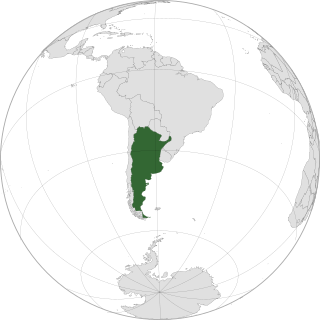
Squatting in Argentina is the occupation of derelict buildings or unused land without the permission of the owner. Shanty towns emerged on the periphery of Buenos Aires from the 1930s onwards and are known as villa miseria. After the 1998–2002 Argentine great depression, 311 worker cooperatives set up across the country as people squatted and re-opened businesses.

During the colonial occupation of Kenya, Black Africans working on farms owned by white settlers were called "squatters" by the British. As of 1945, there were over 200,000 such squatters in the Highlands and more than half were Kikuyu. The Mau Mau rebellion began amongst these squatters in the late 1940s and after independence in the early 1960s, peasants started squatting land in rural areas without the permission of the owner.
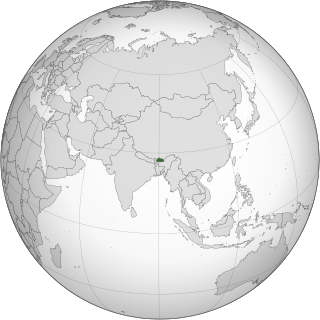
In 2001, about 10 per cent of the population of Bhutan's capital city Thimphu were living in squatted informal settlements; by 2019, the figure had dropped to 2 per cent since the squatters had been rehoused. There are also rudimentary settlements on the periphery of other cities such as Phuntsholing and Samdrup Jongkhar. The inhabitants work as manual labourers or in the informal economy.
